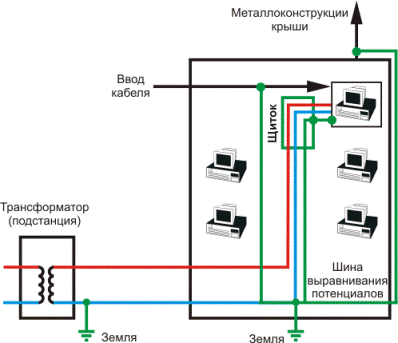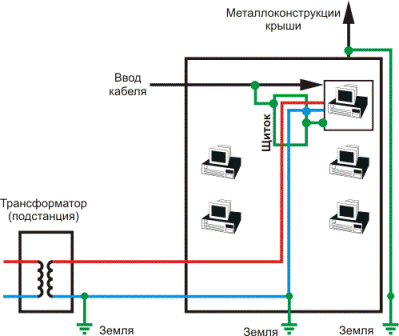Cable lightning protection
The main task can be formulated. This is, firstly, to protect the network from thunderstorms (mainly atmospheric electrical discharges), and secondly, to do this without harming the existing electrical wires (and the consumers connected to it). In this case, it is often necessary to solve the "collateral" problem of bringing the earthing and potential equalizing devices to normal condition in a real distribution network.
Basic concepts
If we talk about documents, then lightning protection must comply with RD 34.21.122-87 "Instructions for the lightning protection device of buildings and structures" and GOST R 50571.18-2000, GOST R 50571.19-2000, GOST R 50571.20-2000.
Here are the conditions:
- Direct lightning strike — direct contact of the lightning rod with a building or structure, accompanied by the flow of lightning through it.
- The secondary manifestation of lightning is the induction of potentials on metal structural elements, equipment, in open metal circuits caused by nearby lightning discharges and creating a risk of sparks in the protected object.
- High-potential drift is the transfer of electrical potentials to the protected building or structure along extended metal communications (underground and ground pipelines, cables, etc.), which occur during direct and close lightning strikes and create a risk of sparks in the protected object.
It is difficult and expensive to protect against a direct lightning strike. A lightning rod cannot be placed over every cable (although you can completely switch to fiber optics with a non-metallic support cable). We can only hope for the negligible probability of such an unpleasant event. And endure the possibility of cable vaporization and complete burnout of the terminal equipment (along with the protections).
On the other hand, a high-potential bias is not too dangerous, of course, for a residential building, not a dust warehouse. In fact, the duration of the pulse caused by lightning is much less than a second (60 milliseconds or 0.06 seconds is usually taken as a test). The cross-section of the twisted-pair wires is 0.4 mm. accordingly, a very large voltage will be required to introduce high energy. This, unfortunately, happens—just as it is entirely possible for a direct lightning strike to hit the roof of a house.
It is not realistic to damage a typical power supply with a short high voltage spike. The transformer just won't let it out of the primary winding. And the pulse converter has enough protection.
An example is electrical wiring in rural areas—where the cables reach the building over the air and are, of course, subject to significant disruption during thunderstorms. No special protection (other than fuses or spark gaps) is normally provided.But cases of failure of electrical appliances are not very common (although they happen more often than in the city).
Potential leveling system.
Thus, the greatest practical danger is the secondary manifestations of lightning (in other words, pickups). In this case, the striking factors will be:
- the appearance of a large potential difference between the conductive parts of the network;
- high voltage induction in long wires (cables)
Protection against these factors is respectively:
- equalization of the potentials of all conductive parts (in the simplest case — connection at one point) and low resistance of the ground loop;
- shielding of shielded cables.
Let's start with a description of the potential leveling system - from this basis, without which the use of any protective devices will not give a positive result.
7.1.87. At the entrance to the building, an equipotential bonding system must be carried out by combining the following conductive parts:
- main (trunk) protective conductor;
- main (trunk) ground wire or main ground clamp;
- steel pipes of communications of buildings and between buildings;
- metal parts of building structures, lightning protection, central heating, ventilation and air conditioning systems. Such conductive parts must be interconnected at the entrance to the building.
- It is recommended that additional equipotential bonding systems be repeated during power transfer.
7.1.88.All exposed conductive parts of fixed electrical installations, conductive parts of third parties and neutral protective conductors of all electrical equipment (including sockets) must be connected to the additional equipotential bonding system...
Schematic grounding of the cable shield, lightning protection and active equipment acc new edition of PUE should be done as follows:

Grounding of cable screens, lightning arresters and active equipment according to the new edition PUE
While the old edition provided for the following scheme:

Grounding of cable shields, lightning arresters and active equipment in the old edition of PUE
The differences, for all their external insignificance, are quite fundamental. For example, for effective lightning protection of active equipment, it is desirable that all potentials oscillate around a single "ground" (also, with low ground resistance).
Alas, too few buildings are built in Russia according to a new, more efficient PUE. And we can firmly say - there is no "earth" in our houses.
What to do in this case? There are two options — to redesign the entire power network at home (an unrealistic option), or to use what is reasonably available (but at the same time remember what to aim for).
Grounding of cables and equipment.
Grounding active equipment is usually easy. If it's an industrial series, then there's probably a dedicated terminal for that. It's worse with cheap desktop models — they simply don't have the concept of "ground" (and therefore nothing to ground). And the greater risk of damage is fully compensated by the lower price.
The cable infrastructure issue is much more complex.The only cable element that can be grounded without losing the useful signal is the shield. Is it advisable to use such cables for laying «vents»? In response, I would just like to quote a long quote:
In 1995, an independent laboratory conducted a series of comparative tests of shielded and unshielded cable systems. Similar tests were carried out in the autumn of 1997. A controlled section of cable 10 meters long was laid in an echo-absorbing chamber protected from external disturbances. One end of the line was connected to a 100Base-T network hub and the other to a PC network adapter. The control part of the cable was exposed to interference with the field strength of 3 V / m and 10 V / m in the frequency range from 30 MHz to 200 MHz. Two significant results were obtained.
First, the level of interference in an unshielded cable of category 5 turns out to be 5-10 times higher than in a shielded cable with an RF field voltage of 3 V / m. Second, in the absence of network traffic, the network concentrator performed on unshielded cable shows more than 80% network load at some frequencies. The signal strength of the 100Base-T protocol above 60 MHz is very low, but very important for waveform recovery. However, even with interference above 100 MHz, the unshielded system failed the test. At the same time, a decrease in data transmission speed by two orders of magnitude was noted.
Shielded cable systems have passed all tests, but effective grounding is essential for their successful operation.
An important point should be noted here.In traditional SCS, grounding is done along the entire length of the line—continuously from one active equipment port to another (although in theory grounding should be provided at a single point). It is extremely difficult to properly ground a large distributed network and most installers generally do not use shielded cables.
In "home" networks, one should not talk about grounding the network, but about grounding individual lines. These. You can think of each individual line as an unshielded twisted pair placed in a metal tube (after all, the purpose of the shield is to protect the "air" part of the line).
This greatly simplifies things. As a result, the use of shielded cable is more than recommended. But only with good grounding when entering the building. It is recommended to do this on both sides according to the following rule:

Grounding of the cable shield
On the one hand, a «dead» earthing is performed. On the other hand, through galvanic isolation (spark gap, capacitor, spark gap). In the case of simple grounding on both sides, in a closed electrical circuit between buildings, unwanted equalization currents and / or stray clamps can occur.
Ideally, it is advisable to ground it with a separate conductor of a decent cross-section to the basement of the house and connect there directly to the equipotential bus. In practice, however, it is sufficient to use the nearest protective zero.At the same time, the effectiveness of the lightning protection of the network decreases, but not too significantly, only slightly (rather in theory than in practice) the probability of damage to electrical consumers in the house from the increased potential increases.
